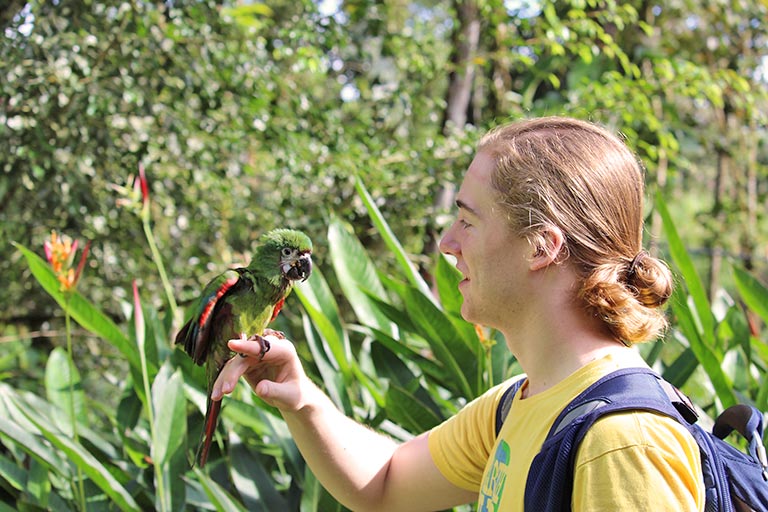Daniel Barry: Student Report from 2017 Alternative Summer Break in Ecuador
Travelling abroad is perhaps one of the most exciting activities of which one can partake. On approach to the airport in Quito, Ecuador, I remember the lights from the roads and buildings scattered about the city. Then the full realization that I was in another country dawned upon me. It seemed like ages before we deplaned, but when we did, my excitement continued to grow. The first element of Ecuadorian culture I noticed was the differently-shaped vehicles. This would be something that became less apparent throughout the week because of its prevalence, but upon returning to the United States, surfaced once more. A similar phenomenon occurred with some of the buildings, which had a different style than do those in the United States.
When we arrived at our hostel, a miniature hotel, that night. We climbed a most decorative stairwell to our rooms, which were part of miniature suites. I woke up around the same time a rooster was crowing and sunlight was pouring in through the windows. We visited two cathedrals that day, one of which was nearly entirely covered in gold on the inside. This exemplifies the extent to which religion is ingrained in the culture. The other cathedral had a very tall tower which tourists can climb, so we climbed to the top.

We stopped for lunch in a restaurant in Quito later that day, where they served the most fresh avocado I have ever tasted. On the next leg of our journey, we rode in a van to Puyo, the city in which the Yanacocha animal sanctuary is located. Reminiscent of a zoo in some ways, this is where we would complete our volunteer project. Beginning the next day, we worked on our service project: building a bridge and a walkway for traversing the sanctuary. The first round of work involved our group splitting up into two teams, one to go into town to prepare the bridge hardware we needed, and the other to move boulders from the sanctuary’s entrance to the work site within the sanctuary. I was assigned to the latter team.
Moving the boulders was hard work. They were a lot heavier than expected, and the wheelbarrows we used to transport the boulders sank into the gravel paths after it started to rain. We didn’t let it slow us down though, as the cool rain was a soothing change from the heat of the sun. After a while, the other team returned and we were served a most delicious and hospitable lunch from the Yanacocha staff. On the second day of work, we dug the foundation of the path and wheeled sand and more boulders to the work site.

I distinctly remember the evolution of my workflow on this day. The worker from Yanacocha who supervised our project told us to space the boulders a specific distance from one another on the edge of the path. I was having difficulty placing them where he envisioned, so instead of both his and my moving boulders from the pile and placing them on the trail, I decided to move them from the pile so that he could place them since he knew where they needed to go. In this way, we were able to work more efficiently.
Before we returned to Quito for our final day in Ecuador, we visited the natural preservation and sister to the Yanacocha animal sanctuary, Tamandua. To visit Tamandua, we had to drive for about 40 minutes to near the edge of the jungle. Then, we hiked for an additional 35 minutes around farmland lush with greenery and exotic plants. The entrance to the Tamandua preserve was the edge of the jungle, a dense forest navigable via a foot trail we followed. We proceeded to hike through the forest and up a hill to a group of three cabins and the most beautiful view of forested mountains imaginable. While there, we hiked with a guide into the jungle to a waterfall! We got to swim near a waterfall, whose beauty was right up there with the view of the mountains.
The next day, we rode back to Quito and passed a volcano on the way there. I never thought I would get to see a volcano in real life. On our final day in Ecuador, we explored Quito one last time. We got to visit the El Panecillo mountain which holds the Virgin of Quito statue, the most prominent structure in all of Quito. This further illustrated the role of religion in the history of Ecuador. At the top of this statue, I could see the tower of the cathedral I climbed on the first day, but it was much lower-down, relative to the statue. I made sure to buy some coffee from a local vendor before heading back to our hostel so that once I got back home, I would be able share a bit of the culture I got to experience.
During our work, I realized the need for volunteers on such projects as these because everything in the Yanacocha animal sanctuary was built from volunteer work, and the area we completed was only one, albeit significant, part of the whole. This in particular stood out to me because despite language barriers and potential unfamiliarity with the technical details and skills needed for our work, we were able to complete the bridge and path well before our deadline. Our physically intense efforts made me appreciate the hard work that the employees at Yanacocha provide on a long-term basis. Getting to travel to Ecuador allowed me to enhance my understanding of the average way of life in different societies and enrich my knowledge of a very culturally diverse nation.

